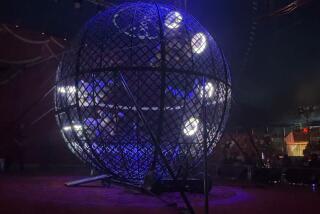Big Top Goes Big Time . . . the Cirque’s Growing Pains
- Share via
Cirque du Soleil may still feature perky young faces in feats of derring-do, but organizationally speaking, they are babes in the big top no more. The Montreal-based circus has come a long way since it first popped up in Los Angeles in 1987, but making it big has been a tightrope walk.
“With success, there’s money and internal change,” says Cirque founding president and former fire-eater Guy Laliberte. “There are always goals that we give ourselves, but it also means new ways of doing things. Going from being street performers to being professionals has created surprises. We were no more the small family organization. We did have to adjust.”
Adjust is an understatement. The expansion of Cirque has entailed diversification and merchandising, along with an exponential increase in output. Once it was a straight shot from the gate to your seat, but today you can’t pass from the ticket-taker to the big top without being dazzled by an array of sweatshirts, jackets, CDs, badges and other Cirque paraphernalia.
Even the expansion just since 1987, when the Cirque opened the L.A. Festival, has been considerable. It’s gone from an $8-million annual operating budget in 1987 to today’s $26-million yearly nut. Five years ago, it used a big top that seated 1,700; since 1990, Cirque has been holding forth under a tarp that holds 2,500.
Most significant, Cirque is no longer just one show. Since it began touring the 1987 production to Europe, Japan and Switzerland during the past couple of years, Cirque has had two troupes going at once, plus sundry other ventures such as an HBO special last year.
In fact, shortly after Cirque du Soleil opens “Saltimbanco” Thursday in Santa Monica, the organization will open yet another show in the Mirage Hotel in Las Vegas. Vegas will also become a second home of sorts, thanks to a special theater that’s being constructed at the Mirage to house a permanent tailor-made Cirque spectacle.
All this go-go, however, has made it that much harder to keep the seat-of-your-pants aesthetic of street performance alive. “There’s a price to pay for success, which is that one has to spend more effort in trying to keep the spirit which brought us together,” admits Laliberte. “Sometimes it’s tough.”
Cirque’s origins trace to 1982 and a group of street performers who called themselves Le Club des Talon Hauts (High Heels Club). Guy Laliberte was one of the members.
Cirque du Soleil was officially launched in 1984, thanks largely to subsidy from the government of Quebec. (Government support has decreased from about 95% to about 1.8% of the budget now.) It first toured to Toronto in 1985, and to more of Canada in 1986.
It was in September, 1987, though, that L.A. and the United States first met Cirque. “The L.A. Festival gave us promotional support, but not a contract,” says Jean David, vice president of marketing and communications. “Cirque had to take all the financial risk. In exchange, we got the right to open the festival.”
The circus got not only boffo box office, but all the Tinseltown courting it could handle. The run extended again and again, as countless film and TV deal makers courted Cirque.
“It could have been a great temptation, but we decided not to enter into any deals,” says Laliberte. “That was wise, knowing that we want to control and organize our own development.”
Still, the Hollywood rush did turn their heads. Negotiations with Columbia and Walt Disney and others eventually fell through, but not before the organization was changed by the attention.
“By the end of ‘88, there were a lot of people who left the company and new people were coming in,” says Laliberte. “There was planning, negotiations for movies that we didn’t get. It took six months to a year to readjust and think of how we were seeing our future.”
“The challenge was to stay ourselves,” adds David.
In 1988, Cirque toured the East Coast. Then, the following year, it brought the same show back to L.A. “We made some mistakes,” admits David. “In 1989, when we came back with the same show, the reviewers didn’t miss the opportunity to give us mixed reviews.”
Other missteps followed. In 1990, Cirque produced itself in London and Paris. “We lost some money there,” recalls David. “In London they had the hottest weather they’d had in the last 60 years, so everybody left. In France, they like more traditional circus, which has less expensive tickets.”
In 1990, Cirque also launched its second show, “Nouvelle Experience,” which toured North America while the first show played in Europe. “We learned from Europe in 1990,” says David. “The contracts that we’ve had since with Japan or Switzerland are no risk at all for us, because the producers are taking the risk.”
And while there’s little denying that Cirque has refined its business savvy over the years, the impact on the artistic product is more ambiguous. Corporate practices have inevitably transformed the familial camaraderie that was so much of Cirque’s charm in 1987.
“We have more responsibility than in ‘87,” says creative director Gilles Ste-Croix, who began as a performer with Cirque in 1984. “My workload in ’87 took one secretary, whereas now I work with three assistant directors.”
The shows themselves have come to rely more on high-tech production, and less on commedia dell’arte-like theatrics. “We have been involving more different mediums in our production,” acknowledges Ste-Croix. “1987 was the first time we designed the production with costumes and a choreographer. Before that, there was not really the budget. The 1990 production was designed even more, moving even further away from circus than the 1987 show.”
“Saltimbanco,” although its name pays homage to 16th-Century Italian street performers, is less reliant on theater than previous Cirque shows. The narrative story line, for instance, figures less prominently than it did in either the 1987 or the 1990 show.
“In 1987, it was still circus,” says Ste-Croix. “Now it’s something of its own, a whole different product. But I don’t think we can turn out shows like McDonalds, with five running around the world at once. Cirque cannot be duplicated that way.”
To some extent, however, it can be cloned. Once the new specially constructed theater is built at the Mirage, Cirque will install a show that will play there for three to five years, at which time it will be replaced by yet another new production.
Meanwhile, Cirque will continue to tour North America. It already has plans, for instance, to return to Los Angeles with a new production in October, 1994. It also expects to be back in Japan with another show by 1994.
The question that remains is not so much whether Cirque can sell tickets this time, but whether all this expansion will fundamentally alter it. “We did flirt with the devil,” says Laliberte. “But today, we make a point of reminding ourselves regularly where we came from.”
More to Read
The biggest entertainment stories
Get our big stories about Hollywood, film, television, music, arts, culture and more right in your inbox as soon as they publish.
You may occasionally receive promotional content from the Los Angeles Times.










